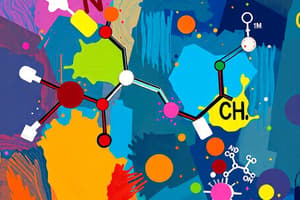Podcast
Questions and Answers
Who is the lecturer for Pharmaceutical Organic Chemistry?
Who is the lecturer for Pharmaceutical Organic Chemistry?
- Dr. Richard Lee
- Dr. Aya Almatary (correct)
- Prof. Jane Doe
- Dr. John Smith
What is the primary focus of the lecture given by Dr. Aya Almatary?
What is the primary focus of the lecture given by Dr. Aya Almatary?
- Biochemistry
- Pharmaceutical Organic Chemistry (correct)
- Physical Chemistry
- Inorganic Chemistry
In which setting is Dr. Aya Almatary presenting her lecture?
In which setting is Dr. Aya Almatary presenting her lecture?
- An academic conference
- A team presentation (correct)
- A research facility
- A laboratory environment
What role does Dr. Aya Almatary hold related to Pharmaceutical Organic Chemistry?
What role does Dr. Aya Almatary hold related to Pharmaceutical Organic Chemistry?
What is most likely the audience for Dr. Aya Almatary's presentation?
What is most likely the audience for Dr. Aya Almatary's presentation?
What is the maximum number of electrons that can occupy the K shell?
What is the maximum number of electrons that can occupy the K shell?
Which shell is designated as the L shell?
Which shell is designated as the L shell?
How many electrons can the N shell accommodate?
How many electrons can the N shell accommodate?
What is the atomic number (Z) of an atom?
What is the atomic number (Z) of an atom?
Which of the following correctly describes principal energy levels?
Which of the following correctly describes principal energy levels?
Which particle has a negative charge?
Which particle has a negative charge?
The M shell is identified by which principal quantum number?
The M shell is identified by which principal quantum number?
What is the actual mass of a proton?
What is the actual mass of a proton?
What role does stereochemistry play in chemistry?
What role does stereochemistry play in chemistry?
Which of the following particles is neutral?
Which of the following particles is neutral?
What is the primary focus of Organic Chemistry within the Pharmaceutical field?
What is the primary focus of Organic Chemistry within the Pharmaceutical field?
Which statement best describes the role of a lecturer in Organic Chemistry?
Which statement best describes the role of a lecturer in Organic Chemistry?
Which area is NOT typically covered in a Pharmaceutical Organic Chemistry course?
Which area is NOT typically covered in a Pharmaceutical Organic Chemistry course?
Why is Organic Chemistry essential for pharmaceutical development?
Why is Organic Chemistry essential for pharmaceutical development?
Which of the following tasks would a lecturer in Organic Chemistry likely NOT perform?
Which of the following tasks would a lecturer in Organic Chemistry likely NOT perform?
What is the maximum number of electrons that can occupy the shell when n = 3?
What is the maximum number of electrons that can occupy the shell when n = 3?
Which of the following statements about electron shells is true?
Which of the following statements about electron shells is true?
What is the pattern for the maximum number of electrons in terms of n?
What is the pattern for the maximum number of electrons in terms of n?
If the second shell (n = 2) is filled, how many electrons does it contain?
If the second shell (n = 2) is filled, how many electrons does it contain?
Considering n values, which shell corresponds to the lowest energy level?
Considering n values, which shell corresponds to the lowest energy level?
Which of the following reflects the main goal of the pharmacy program?
Which of the following reflects the main goal of the pharmacy program?
What is emphasized for graduates in the context of their role in healthcare?
What is emphasized for graduates in the context of their role in healthcare?
Which value is NOT mentioned in the pharmacy program's principles?
Which value is NOT mentioned in the pharmacy program's principles?
What is one of the strategic objectives of the pharmacy college?
What is one of the strategic objectives of the pharmacy college?
How does the program aim to enhance academic and administrative performance?
How does the program aim to enhance academic and administrative performance?
Which of the following is a significant aspect of the college's mission?
Which of the following is a significant aspect of the college's mission?
What role does scientific research play in the pharmacy program?
What role does scientific research play in the pharmacy program?
Which approach is used to assure continuous improvement in education?
Which approach is used to assure continuous improvement in education?
Flashcards
Organic Chemistry
Organic Chemistry
A branch of chemistry that focuses on the structure, properties, and reactions of organic compounds, which primarily contain carbon atoms.
Lecturer
Lecturer
A person who gives lectures on a specific subject.
Pharmaceutical Chemistry
Pharmaceutical Chemistry
The study of the preparation, properties, and uses of drugs and pharmaceuticals.
Pharmaceutical Organic Chemistry
Pharmaceutical Organic Chemistry
Signup and view all the flashcards
Team Presentation
Team Presentation
Signup and view all the flashcards
Professor
Professor
Signup and view all the flashcards
Presenter
Presenter
Signup and view all the flashcards
Atomic Number (Z)
Atomic Number (Z)
Signup and view all the flashcards
Electron
Electron
Signup and view all the flashcards
Proton
Proton
Signup and view all the flashcards
Neutron
Neutron
Signup and view all the flashcards
Principal Energy Level (Shell)
Principal Energy Level (Shell)
Signup and view all the flashcards
Electron Capacity in a Shell
Electron Capacity in a Shell
Signup and view all the flashcards
Sub-Shells
Sub-Shells
Signup and view all the flashcards
Number of Sub-Shells
Number of Sub-Shells
Signup and view all the flashcards
Orbitals
Orbitals
Signup and view all the flashcards
Goals of studying pharmaceutical organic chemistry
Goals of studying pharmaceutical organic chemistry
Signup and view all the flashcards
Why study pharmaceutical organic chemistry?
Why study pharmaceutical organic chemistry?
Signup and view all the flashcards
SWOT analysis
SWOT analysis
Signup and view all the flashcards
Strengths
Strengths
Signup and view all the flashcards
Weaknesses
Weaknesses
Signup and view all the flashcards
Opportunities
Opportunities
Signup and view all the flashcards
Threats
Threats
Signup and view all the flashcards
Electron Shell
Electron Shell
Signup and view all the flashcards
Principal Quantum Number (n)
Principal Quantum Number (n)
Signup and view all the flashcards
Maximum Electron Capacity
Maximum Electron Capacity
Signup and view all the flashcards
Energy Level Trend
Energy Level Trend
Signup and view all the flashcards
Electron Capacity of the 3rd Shell
Electron Capacity of the 3rd Shell
Signup and view all the flashcards
Study Notes
Pharmaceutical Organic Chemistry 1 (Introduction)
- The course is taught by Dr. Aya Almatary
- The presentation includes a team introduction with Prof. Magda Abdelaziz, Dr Abdelrahman Hamdy, and Dr Mohamed Zidan
- The course aims to develop students for pharmaceutical practice and research.
- The lecture outlines include an introduction, course content, grading, atomic structure, electron configurations, and chemical bonding.
- The lecture also discusses the importance of studying the subject, and provides an outline of the areas to be covered.
- The course content will include topics like alkane, alkene, alkyne, stereo chemistry, alkyl halides, alcohol, and ethers.
Atomic Structure
- An atom has a central nucleus with electrons orbiting around it.
- The nucleus contains protons (positively charged) and neutrons (neutral).
- Electrons orbit the nucleus and have a negative charge.
- The atomic number (Z) is the number of protons in an atom's nucleus, or the number of electrons
- The mass number (A), is the number of protons plus neutrons.
- Isotopes are atoms of the same element that have different numbers of neutrons but the same atomic number.
Properties of Subatomic Particles
- Electron: Symbol (e⁻), Charge (-1), Mass (9.11 x 10⁻²⁸ g)
- Proton: Symbol (p⁺), Charge (+1), Mass (1.67 x 10⁻²⁴ g)
- Neutron: Symbol (n⁰), Charge (0), Mass (1.67 x 10⁻²⁴ g)
Important Definitions
- Atomic number (Z): The number of protons or electrons
- Mass number (A): The sum of protons and neutrons
- Isotopes: Atoms of the same element that have different numbers of neutrons, and thus different mass numbers.
Electron Configuration
- Electrons are added to orbitals in a specific order following the Aufbau principle, the Pauli exclusion principle, and Hund's rule.
- Aufbau principle: Electrons fill the lowest energy orbitals first.
- Pauli exclusion principle: Each orbital can hold a maximum of two electrons with opposite spins.
- Hund's rule: Electrons fill orbitals of equal energy singly before pairing up.
Chemical Bonding
- Atoms bond to achieve a stable electron configuration (octet rule).
- Bonding may occur by losing, gaining, or sharing electrons.
- Ionic Bonding: The complete transfer of valence electrons between atoms, and thus a formation of ions with an attractive force occurring in between those ions.
- Covalent Bonding: Sharing of valence electrons between atoms, with overlapping orbitals creating new molecular orbitals.
Studying That Suits You
Use AI to generate personalized quizzes and flashcards to suit your learning preferences.




